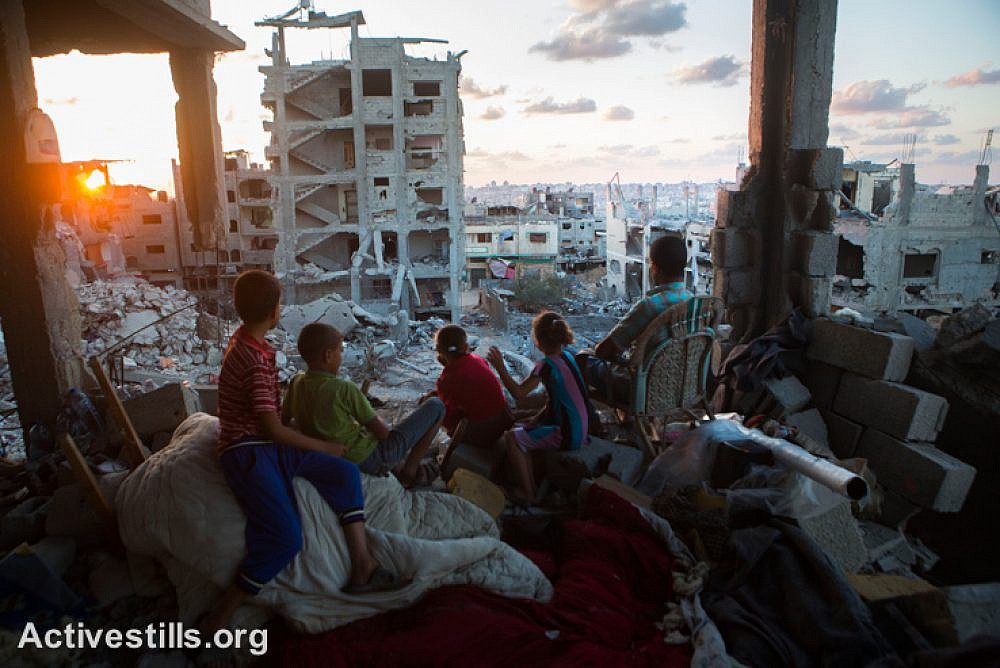Both contenders for Israel’s premiership, Benjamin Netanyahu and Benny Gantz, are hoping to give the victory speech after today’s vote. Yet regardless of who – if any – emerges the winner, Israelis have already been presented with this election’s victory image: the humiliating poster featuring Palestinian leaders kneeling, blindfolded and defeated, against the backdrop of a destroyed city.
The campaign, advertised on billboards by the far-right group Israel Victory Project and quickly taken down by order of Tel Aviv’s mayor, is the epitome of Israel’s current phase of control over the Palestinians. Though they were in the public eye only for a short time, these billboards are already etched in the collective consciousness. After all, that is where the idea came from: the minds of a growing number of Jews in Israel who are publicly expressing their vision of absolute “victory” over the Palestinians — not only in the depths of their subconscious, but most openly and practically.
If one doubts this image represents the broad Jewish consensus in Israel, recall the message Gantz chose to launch his first election campaign: boasting about the 2014 death toll in a Gaza, and showing the destruction Israel rained there. Given the same iconography, the same collective consciousness, the same consensus, how different is the “extremist” billboard from the “moderate alternative?”
To the side of Gantz’s Blue and White party is Netanyahu’s Likud, which went to lengths to make room in the Knesset for the successors of Meir Kahane’s overtly racist party. These now call, as part of their political platform, for the destruction of Khan al-Ahmar, a small Palestinian shepherding community in the West Bank that has become a poignant symbol of the Palestinians’ struggle to hold on to their land. Demands to expel this community are coming not only from Itamar Ben Gvir’s ultra-right, but from mainstream key politicians including Likud’s Gideon Sa’ar and Blue and White’s Moshe Ya’alon. Meanwhile, the attorney general is hard at work devising solutions to the “legal obstacles” to the community’s forcible transfer, which the Supreme Court repeatedly sanctioned. The question therefore becomes: who does not share the vision of a future in which the Palestinians kneel before Israel, defeated, against the backdrop of their destroyed communities?
This is not merely about a billboard poster. This victory image is the vulgar graphic representation of the political plan now being touted to fulfill the next phase of this very vision: U.S. President Donald Trump’s “peace” plan.

Like its visual equivalent, the plan is based, at heart, on humiliating the Palestinians. It carves out for them a future restricted to Bantustans with no political rights, freedom of movement, or equality. The broad Jewish support for this plan ranges from Benny Gantz to U.S. Ambassador David Friedman, from Netanyahu to Jewish Home MK Bezalel Smotrich. Like Smotrich, many settlers oppose the plan, supposedly for fear it will establish “a Palestinian state” — the very same state Trump’s plan openly, although belatedly, spells out its burial.
This overwhelming support in Israel for Trump’s plan is based on a vision that — even if only gradually implemented over the years, and coined by varying names — has in essence remained one and the same: that the entire area between the Jordan River and the Mediterranean Sea will be governed by Jews, and controlled by them and for them. This vision has guided the state since its founding, and the only question that remained was what to do with the Palestinians. Over the years, Israel gave various answers to this, on either side of the Green Line. But while it increasingly blurs this line for its Jewish citizens, two areas along this fading line make clear what Israel is aspiring toward.
One is the Wadi Ara in the north, which Israel coveted for geographical reasons in 1949. That land came with a demographic price, though: Palestinians. Calls to “fix” this and decrease the number of Palestinians in Israel are now rising to the surface — not only by the far-right nationalist Avigdor Liberman, who expressed this “extremist” view a decade ago, but at the request of the prime minister himself, as an explicit part of Trump’s plan.
The other is East Jerusalem, an area Israel engineered to our ends in 1967 by annexing that first chunk of the West Bank. The demographic “fix” there has been gradually implemented over the last decade, in the form of Palestinian neighborhoods banished to the other side of the separation wall Israel built inside the city, and the movement of more Palestinians into them.

We desire the land, but not the people who live on it. The answer, for now, is demographic reengineering of this space. Yet this still leaves an unwanted population west of the river. What if they can be “persuaded” to leave? That is a euphemism that starts with “encouraging emigration” — as the Israeli cabinet discussed recently in the context of Palestinians in Gaza — and ends with ethnic cleansing.
An image of victory? It takes a mind that is historically myopic and drunk on power to believe that, for those depicted on their knees will not remain humiliated forever. Even on your knees — especially on your knees — human beings can look to the future with clarity and dignity. Look, and remember that the city now in ruins will be rebuilt, for generations to come, not by those who put their faith in brute force, but by those who build on the moral power of freedom, justice, and equality.

